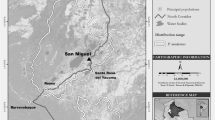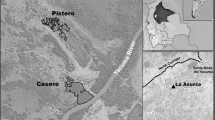Abstract
To avoid competition, ecologically similar and closely related species tend to differ in their patterns of habitat use when they live in sympatry. We compared ranging patterns of brown howler (Alouatta guariba) and black and gold howler (A. caraya) monkeys living syntopically, i.e., co-occurring and overlapping their ranges in the same habitat within the zone of sympatry, in the Atlantic Forest of northeastern Argentina with the objective of evaluating whether their use of space contributes to the avoidance of interspecific competition for food resources. During 12 mo we collected data on the ranging behavior of 2 groups of each howler species. We analyzed annual and seasonal daily path lengths and movement rates, home range size, use and overlap, habitat and vertical strata use, and intergroup encounters. Black and gold howlers traveled farther and faster during the time of relative food abundance (abundant season) than during the time of relative food shortage (lean season), and their movement rates were affected by group identity and increased with the proportion of fruits in the diet. Brown howlers’ traveling patterns were not affected by any of these factors. Home ranges for both species (95% fixed kernel; brown howlers: 31–70 ha, black-and-gold howlers: 17–112 ha) were among the largest recorded for Alouatta. For both species, core areas (50% fixed kernel) were larger for larger versus smaller groups, and decreased in the lean season compared to the abundant season. Both species showed similar patterns of habitat use, except for a slight vertical stratification. Groups of different species overlapped their ranging areas consistently more and responded to one another less aggressively during encounters than groups of the same species, suggesting that interspecific spatial niche separation for these two syntopic species is not occurring. The vertical stratification, as well as a day-to-day avoidance strategy, may be the only responses of species to one another that could reduce the potentially high levels of competition for food suggested by their elevated trophic niche overlap. A high degree of niche overlap may explain the parapatric distribution of howlers and other closely related and ecologically similar species of primates.




Similar content being viewed by others
References
Agostini, I. (2009). Ecology and behavior of two howler monkey species (Alouatta guariba clamitans and Alouatta caraya) living in sympatry in Northeastern Argentina. PhD Dissertation. Rome: University La Sapienza.
Agostini, I., Holzmann, I., & Di Bitetti, M. S. (2008). Infant hybrids in a newly formed mixed-species group of howler monkeys (Alouatta guariba clamitans and Alouatta caraya) in northeastern Argentina. Primates, 49, 304–307.
Agostini, I., Holzmann, I., & Di Bitetti, M. S. (2010). Are howler monkey species ecologically equivalent? Trophic niche overlap in syntopic Alouatta guariba clamitans and Alouatta caraya. American Journal of Primatology, 72, 173–186.
Aguiar, L. M., Mellek, D. M., Abreu, K. C., Boscarato, T. G., Bernardi, I. P., Miranda, J. M. D., et al. (2007). Sympatry between Alouatta caraya and Alouatta clamitans and the rediscovery of free-ranging potential hybrids in Southern Brazil. Primates, 48, 245–248.
Altmann, J. (1974). Observational study of behavior: sampling methods. Behaviour, 49, 227–267.
Bicca-Marques, J. C., Prates, H. M., Cunha, R., de Aguiar, F., & Jones, C. B. (2008). Survey of Alouatta caraya, the black-and-gold howler monkey, and Alouatta guariba clamitans, the brown howler monkey, in a contact zone, State of Rio Grande do Sul, Brazil: evidence for hybridization. Primates, 49, 246–252.
Blundell, G. M., Maier, J. A. K., & Debevec, E. M. (2001). Linear home ranges: effects of smoothing, sample size, and autocorrelation on kernel estimates. Ecological Monographs, 71, 469–489.
Bocian, C. M. (1997). Niche separation of black-and-white colobus monkeys (Colobus angolensis and C. guereza) in the Ituri Forest. PhD Dissertation. New York: City University of New York.
Bravo, S. P., & Sallenave, A. (2003). Foraging behavior and activity patterns of Alouatta caraya in the Northeastern Argentinean Fooded Forest. International Journal of Primatology, 24, 825–846.
Brown, A. D., & Zunino, G. E. (1994). Hábitat, densidad y problemas de conservación de los primates de Argentina. Vida Silvestre Neotropical, 3, 30–40.
Clutton-Brock, T. H., & Harvey, P. H. (1977). Primate ecology and social organization. Journal of Zoology (London), 183, 1–39.
Cortés-Ortiz, L., Bermingham, E., Rico, C., Rodríguez-Luna, E., Sampaio, I., & Ruiz-García, M. (2003). Molecular systematics and biogeography of the neotropical monkey genus, Alouatta. Molecular Phylogenetics and Evolution, 26, 64–81.
Crespo, J. A. (1982). Ecología de la comunidad de mamíferos del Parque Nacional Iguazú, Misiones. Revista del Museo Argentino de Ciencias Naturales, Ecología III, 2, 1–172.
Crockett, C. M., & Eisenberg, J. F. (1987). Howlers: Variations in group size and demography. In B. B. Smuts, D. L. Cheney, R. M. Seyfarth, R. W. Wrangham, & T. T. Struhsaker (Eds.), Primate societies (pp. 54–68). Chicago: University of Chicago Press.
da Cunha, R. G. T., & Byrne, R. W. (2006). Roars of black howler monkeys (Alouatta caraya): evidence for a function in inter-group spacing. Behaviour, 143, 1169–1199.
de Solla, S. R., Bonduriansky, R., & Brooks, R. J. (1999). Eliminating autocorrelation reduces biological relevance of home range estimates. Journal of Animal Ecology, 68, 221–234.
Di Bitetti, M. S. (2001). Home range use by the tufted capuchin monkey, Cebus apella nigritus, in a subtropical rainforest of Argentina. Journal of Zoology, London, 253, 33–45.
Di Fiore, A., & Campbell, C. J. (2007). The Atelines: Variation in ecology, behavior, and social organization. In C. J. Campbell, A. Fuentes, K. C. MacKinnon, M. Panger, & S. K. Bearder (Eds.), Primates in perspective (pp. 155–185). New York: Oxford University Press.
Diaz, G. B., & Ojeda, R. A. (2000). Libro Rojo de Mamíferos Amenazados de la Argentina. Buenos Aires: Sociedad Argentina para el Estudio de los Mamíferos.
Dunbar, R. I. M. (1988). Primate social systems. Ithaca: Cornell University Press.
Fashing, P. J. (2001). Activity and ranging patterns of guereza. International Journal of Primatology, 22, 549–578.
Ganzhorn, J. U. (1989). Niche separation of seven lemur species in the eastern rainforest of Madagascar. Oecologia, 79, 279–286.
Gautier-Hion, A., Quris, R., & Gautier, J.-P. (1983). Monospecific vs. polyspecific life: a comparative study of foraging and antipredatory tactics in a community of Cercopithecus monkeys. Behavioral Ecology and Sociobiology, 12, 325–335.
Groves, C. P. (2001). Primate taxonomy. Washington: Smithsonian Institution.
Hooge, P. N., Eichenlaub, W. M., & Solomon, E. K. (1999). Using GIS to analyze animal movements in the marine environment. Unpublished manuscript and online documentation: http://www.absc.usgs.gov/glba/gistools/index.htm.
Isbell, L. A. (1991). Contest and scramble competition: patterns of female aggression and ranging behavior among primates. Behavioral Ecology, 2, 143–155.
Janson, C. H. (1998). Experimental evidence for spatial memory in foraging wild capuchin monkeys, Cebus apella. Animal Behavior, 55, 1229–1243.
Janson, C. H., & Goldsmith, M. L. (1995). Predicting group size in primates: foraging costs and predation risks. Behavioral Ecology and Sociobiology, 6, 326–336.
Kernohan, B. J., Gitzen, R. A., & Millspaugh, J. J. (2001). Analysis of animal space use and movements. In J. J. Millspaugh & J. M. Marzluff (Eds.), Radio tracking and animal populations (pp. 125–166). San Diego: Academic.
Kinzey, W. G. (1982). Distribution of primates and forest refuges. In G. T. Prance (Ed.), Biological diversification in the tropics (pp. 455–482). New York: Columbia University Press.
Kinzey, W. G., & Gentry, A. H. (1979). Habitat utilization in two species of Callicebus. In R. W. Sussman (Ed.), Primate ecology: Problem-oriented field studies (pp. 89–100). New York: Wiley.
Kowalewski, M. M. (2007). Patterns of affiliation and co-operation in howler monkeys: an alternative model to explain social organization in non-human primates. PhD Dissertation. Urbana: University of Illinois.
Krebs, C. J. (1989). Ecological methodology. New York: Harper and Row.
MacKinnon, J. R., & MacKinnon, K. S. (1980). Niche differentiation in a primate community. In D. J. Chivers (Ed.), Malayan forest primates (pp. 167–190). New York: Plenum.
Milton, K. (1980). The foraging strategy of howler monkey: A study in primate economics. New York: Columbia University Press.
Milton, K. (1998). Physiological ecology of howlers (Alouatta): energetic and digestive considerations and comparison with the Colobinae. International Journal of Primatology, 19, 513–548.
Milton, K., & May, M. L. (1976). Body weight, diet and home range area in primates. Nature, 259, 459–462.
Oates, J. F. (1977). The guereza and its food. In T. H. Clutton-Brock (Ed.), Primate ecology: Studies of feeding and ranging behavior in lemurs, monkeys and apes (pp. 275–321). London: Academic.
Placci, L. (1995). Estructura y comportamiento fenológico en relación a un gradiente hídrico en bosques del Este de Formosa, Argentina. PhD Dissertation. La Plata: Universidad Nacional de La Plata, Argentina.
Rumiz, D. I. (1990). Alouatta caraya: population density and demography in Northern Argentina. American Journal of Primatology, 21, 279–294.
Seaman, D. E., & Powell, R. A. (1996). An evaluation of the accuracy of kernel density estimators for home range analysis. Ecology, 77, 2075–2085.
Sekulic, R. (1982a). Daily and seasonal patterns of roaring and spacing in four red howler (Alouatta seniculus) troops. Folia Primatologica, 39, 22–48.
Sekulic, R. (1982b). The function of howling in red howler monkeys (Alouatta seniculus). Behaviour, 81, 38–54.
Sokal, R. R., & Rohlf, F. J. (1995). Biometry. New York: Freeman.
Stevenson, P. R., Quiñones, M. J., & Ahumada, J. A. (2000). Influence of fruit availability on ecological overlap among four neotropical primates at Tinigua National Park, Colombia. Biotropica, 32, 533–544.
Strier, K. B. (1992). Atelinae adaptations: behavioral strategies and ecological constraints. American Journal of Physical Anthropology, 88, 515–524.
Sussman, R. W., & Garber, P. A. (2007). Cooperation and competition in primate social interactions. In C. J. Campbell, A. Fuentes, K. C. MacKinnon, M. Panger, & S. K. Bearder (Eds.), Primates in perspective (pp. 636–651). New York: Oxford University Press.
Terborgh, J. (1983). Five new world primates. Princeton: Princeton University Press.
van Schaik, C. P. (1989). The ecology of social relationships amongst female primates. In V. Standen & R. Foley (Eds.), Comparative socioecology: The behavioural ecology of humans and other mammals (pp. 195–218). Oxford: Blackwell.
Waser, P. M. (1987). Interactions among primate species. In B. B. Smuts, R. W. Wrangham, D. L. Cheney, R. M. Seyfarth, & T. T. Struhsaker (Eds.), Primate societies (pp. 210–226). Chicago: University of Chicago Press.
Worton, B. J. (1989). Kernel methods for estimating the utilization distribution in home-range studies. Ecology, 70, 164–168.
Yeager, C. P., & Kirkpatrick, C. R. (1998). Asian colobine social structure: ecological and evolutionary constraints. Primates, 39, 147–155.
Acknowledgments
We thank the Ministry of Ecology of Misiones for the research permit, and the Argentinean National Commission for Spatial Activities (CONAE), which provided the satellite image of the park in agreement with the Argentinean National Park Administration. We thank D. Colcombet for facilitating accommodations at the field site, and park rangers for their support during the study. The field work would have been impossible without the hard work and long-term commitment of E. Pizzio, N. Areta, B. Ripoll, M. Brividoro, R. Pfoh, V. Orosa, D. Muñoz, E. Acevedo, and the help of 16 other field assistants, who collaborated in the data collection and other field activities. We thank V. Benesovsky for her advice on GIS techniques, and M. Srur and F. Gatti for their help in the vegetation survey and identification of plants. Prof. C. H. Janson, Dr. E. Visalberghi, and 2 anonymous reviewers provided helpful comments on the manuscript. This research was supported by grants of the Argentinean Consejo Nacional de Investigaciones Científicas y Técnicas (PIP 6318), Cleveland Metropark Zoo (Scott Neotropical Fund), Primate Conservation Inc., Conservation International (Primate Action Fund), International Primatological Society (Conservation Grant), and Idea Wild.
Author information
Authors and Affiliations
Corresponding author
Rights and permissions
About this article
Cite this article
Agostini, I., Holzmann, I. & Di Bitetti, M.S. Ranging Patterns of Two Syntopic Howler Monkey Species (Alouatta guariba and A. caraya) in Northeastern Argentina. Int J Primatol 31, 363–381 (2010). https://doi.org/10.1007/s10764-010-9390-x
Received:
Accepted:
Published:
Issue Date:
DOI: https://doi.org/10.1007/s10764-010-9390-x




